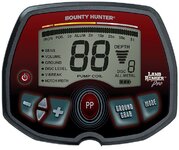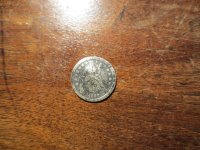- Nov 24, 2006
- 15,865
- 24,001
- Detector(s) used
- Nokta Simplex, Land Ranger Pro, Quick Draw Pro, Deteknix XPointer
- Primary Interest:
- Metal Detecting
The Land Ranger Pro (and even the Quick Draw Pro) uses a slightly different numeric ID over the Teks and other Bounty Hunter machines. The QDP segments are now divided into 9 rather than 8. And the LRP into 43. The 9th segment is to give Iron it's own area, thus dividing the remaining into 8 rather than 7 for precious metals. Another important change is that the the Iron segment on the LRP and QDP comprises 1-19 of the numeric scale. Thus leaving 8 segments to divide out the remaining 80 numbers. The Teknetics Greeks, Euroteks, Bounty Hunter Platinum, defines Iron in the numerics of 1-39. Precious metals are left in a field of the remaining 60 to divide into the 7 remaining segments.
If some seeks Iron (as in relics), the Teks, Platinum will offer a break down further of the Irom over the LRP, QDP. But if one is seeking precious metals only, this 80 number breakdown provides a bit more in ID, especially for slightly overlapping conductivity of treasure and junk.
One nice feature of the LRP is it's 43 segment conductivity arc.

The first 3 large boxes on the left represent Iron. Typically about 7 numerics each. This leaves the remaining 40 to be divided into the remaining 80 numbers for precious metals, or 2 numbers per. Usually the detection of metal illuminates 2-3 small segments, but the single segment to the right is the segment that the manual says is the stongest, or true identifier.
Since the Eurotek Pro uses the same process, the segments are eliminated and the Iron range is expanded due the different targets obtained in Euro-Asian type areas where ancient treasures are Iron based as well. The American coin segments are usually not advantageous to Europeans and Canadians with different coin metrics.
The QDP is a 9 segment unit as well. It's 8 remaining segments divided into 80, basically 10 per, but not all equal. Where nickles hit in the 50s on the other machines, the BH Pros are usually in the 30s. This opens up a wider scale to judge typical difference between, lets say "tabs" and "nickles".
All in all, the LRP and QDP are geared toward an American audience, and set up more for precious metals than Iron relics, but can do both.
The conductivity arc is used for a few other purposes in setting up the machine. But I'll leave that for another thread.
It will be interesting to see what FTP uses in the new Fishers. I like their innovative attitude once I can figure out what they are trying to accomplish.
I hope this helps someone in understanding this slightly complex machine.
If some seeks Iron (as in relics), the Teks, Platinum will offer a break down further of the Irom over the LRP, QDP. But if one is seeking precious metals only, this 80 number breakdown provides a bit more in ID, especially for slightly overlapping conductivity of treasure and junk.
One nice feature of the LRP is it's 43 segment conductivity arc.

The first 3 large boxes on the left represent Iron. Typically about 7 numerics each. This leaves the remaining 40 to be divided into the remaining 80 numbers for precious metals, or 2 numbers per. Usually the detection of metal illuminates 2-3 small segments, but the single segment to the right is the segment that the manual says is the stongest, or true identifier.
Since the Eurotek Pro uses the same process, the segments are eliminated and the Iron range is expanded due the different targets obtained in Euro-Asian type areas where ancient treasures are Iron based as well. The American coin segments are usually not advantageous to Europeans and Canadians with different coin metrics.
The QDP is a 9 segment unit as well. It's 8 remaining segments divided into 80, basically 10 per, but not all equal. Where nickles hit in the 50s on the other machines, the BH Pros are usually in the 30s. This opens up a wider scale to judge typical difference between, lets say "tabs" and "nickles".
All in all, the LRP and QDP are geared toward an American audience, and set up more for precious metals than Iron relics, but can do both.
The conductivity arc is used for a few other purposes in setting up the machine. But I'll leave that for another thread.
It will be interesting to see what FTP uses in the new Fishers. I like their innovative attitude once I can figure out what they are trying to accomplish.
I hope this helps someone in understanding this slightly complex machine.





